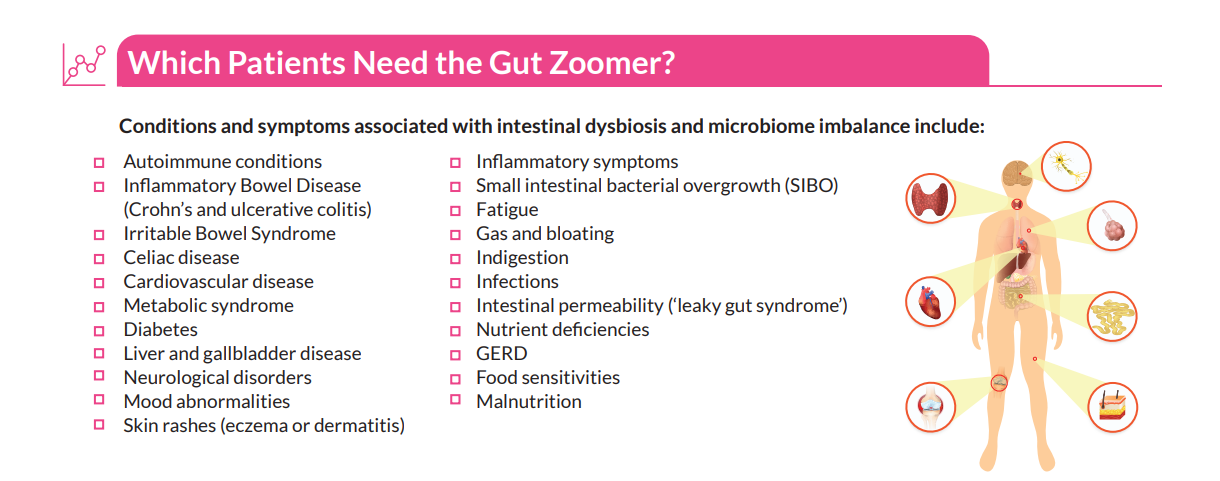The Gut ZoomerTM is the most comprehensive gut microbiome test available on the market to clinicians, including over 170 species and genus-level measurements, as well as phylum assessments and two diversity indexes. We also provide recommendations for 35 commonly used probiotic products that may be appropriate based on risks determined by lab test results. Vibrant’s proprietary microchip technology allows for simultaneous detection of DNA from almost 200 species and genera of microorganisms from a one-time collection of stool sample.
Bacteria include:
- Commensals (including probiotics)
- Acinetobacter
- Actinomyces
- Akkermansia
- Akkermansia muciniphila
- Alistipes
- Alloprevotella
- Anaerostipes
- Atopobium
- Atopobium parvulum
- Bacillus coagulans
- Bacillus subtilis
- Bacteroidales
- Bacteroides
- Bacteroides caccae
- Bacteroides vulgatus
- Bacteroidetes
- Bacteroidetes/Firmicutes ratio
- Bifidobacterium
- Barnesiella
- Bifidobacteria
- Bifidobacterium adolescentis
- Bifidobacterium animalis
- Bifidobacterium animalis subsp Lactis
- Bifidobacterium bifidum
- Bifidobacterium breve
- Bifidobacterium brevis
- Bifidobacterium catenulatum
- Bifidobacterium dentium
- Bifidobacterium infantis
- Bifidobacterium lactis
- Bifidobacterium Longum
- Bifidobacterium spp
- Blautia
- Blautia hydrogenotorophica
- Bradyrhizobiaceae
- Butyricicoccus
- Butyricimonas
- Butyrivibrio
- Catenibacterium
- Cedecea
- Cetobacterium
- Christensenellaceae minuta
- Citrobacter
- Clostridia clusters IV
- Clostridia clusters XIVa
- Clostridia clusters XVIII
- Clostridiales Family XIV Incertae Sedis
- Clostridium
- Clostridium hathewayi
- Clostridium ramosum
- Clostridium symbiosum
- Clotridiales Incertae Sedis IV,
- Collinsella
- Coprobacillus
- Coprococcus
- Dermabacter
- Desulfovibrio piger
- Desulfovibrio
- Dialister invisus
- Dorea
- Dysgonomonas
- Edwardsiella
- Eggerthella lenta
- Enterobacter
- Enterobacter aerogenes
- Enterobacteria
- Enterobacteriaceae
- Enterococcus
- Enterococcus gallinarum
- Escherichia
- Escherichia coli
- Escherichia coli Nissle
- Eubacterium
- Eubacterium rectale
- Faecalibacterium prausnitzii
- Faecalibacterium
- Firmicutes
- Fusobacteria
- Fusobacterium
- Haemophilus
- Hafnia
- Holdemania
- Lachnospiraceae
- Lactobacillaceae
- Lactobacillus
- Lactobacillus acidophillus
- Lactobacillus animalis
- Lactobacillus brevis
- Lactobacillus bulgaricus
- Lactobacillus casei
- Lactobacillus fermentum
- Lactobacillus murinus
- Lactobacillus paracasei
- Lactobacillus plantarum
- Lactobacillus reuteri
- Lactobacillus rhamnosus
- Lactobacillus ruminis
- Lactobacillus sakei
- Lactobacillus salivarius
- Lactococcus
- Leuconostoc
- Marvinbryantia
- Megamonas
- Methanobrevibacter
- Methanobrevibacter smithii
- Micrococcus
- Mitsuokella
- Mycoplana
- Odoribacter
- Oscillospira
- Paenibacillus
- Parabacteroides
- Paraprevotella
- Pediococcus
- Peptostreptococcus
- Phascolarctobacterim
- Porphyromonas
- Porphyromonas gingivalis
- Prevotella
- Prevotella copri
- Prevotellaceae /Bacteroidetes (P/B)
- Propionibacterium
- Propionibacterium freudenreichii
- Proteobacteria
- Proteus mirabilis
- Pseudobutyrivibrio
- Pseudoflavonifractor
- Psuedomonas
- Roseburia
- Roseburia intestinalis
- Ruminococcaceae
- Ruminococcus
- Ruminococcus bromii
- Ruminococcus gnavus
- Ruminococcus obeum
- Saccharomyces boulardii
- Solobacterium moorei
- Staphylococcaceae
- Staphylococcus
- Staphylococcus epidermidis
- Staphylococcus pasteuri
- Streptococcus spp
- Streptococcus thermophiles
- Subdoligranulum
- Tannerella
- Turicibacter
- Tyzzerella
- Tyzzerella 4
- Veillonella
- Veillonellaceae
- Weissella
- Yokenella
- Cedecea
- Cetobacterium
- Coprobacillus
- Dysgonomonas
- Enterobacter
- Hafnia
- Holdemania
- Megamonas
- Mitsuokella
- Odoribacter
- Paenibacillus
- Parabacteroides
- Paraprevotella
- Porphyromonas
- Pseudoflavonifractor
- Subdoligranulum
- Turicibacter
- Weissella
- Yokenella
Pathogenic bacteria include:
- Clostridium difficile Toxin A
- Clostridium difficile Toxin B
- Campylobacter spp
- Campylobacter jejuni
- Campylobacter coli
- Campylobacter upsaliensis
- Plesiomonas shigelloides
- Vibrio (parahaemolyticus)
- Enteropathogenic E.coli (EPEC)
- Enterotoxigenic E.coli (ETEC)Lt/St
- E.coli O157
- Shiga-Like Toxin Producing E.coli(STEC)Stx1/Stx2
- Shigella/EIEC
- Helicobacter pylori
- Listeria
- Vibrio (cholerae)
- Enteroaggregative E.coli(EAEC)
- Klebsiella pneumoniae
- Edwardsiella tarda
- Yersinia enterocolitica
- Vibrio (vulnificus )
- Salmonella
- Cryptosporidium
Parasites include:
- Cryptosporidium
- Entamoeba histolytica
- Giardia lamblia
- Cyclospora cayetanensis
- Chilomastix mesnili
- Cyclospora spp.
- Dientamoeba fragilis
- Endolimax nana
- Entamoeba coli
- Pentatrichomonas hominis
- Larval Nematode
- Ascaris lumbricoides
- Strongyloides stercoralis
- Taenia solium
- Schistosoma
- Blastocystis hominis
- Trichomonas hominis
- Isospora belli
- Fasciola/Fasciolopsis
- Hymenolepis
- Dipylidium caninum
- Diphyllobothrium datum
- Trichuris trichina
- Enterobius vermcularis
- Mansonella
Fungi include:
- Candida albicans
- Candida spp.
- Geotrichum spp.
- Microsporidium spp.
- Rodotorula spp.
- Ancylostoma duodenale
- Necator americanus
- Trichuris trichiura
- Taenia spp.
Viruses include:
- Adenovirus F40/41
- Rotavirus A
- Astrovirus
- Norovirus GI
- Norovirus GII
- Sapovirus I
- Sapovirus II
- Sapovirus IV
- Sapovirus V
- Cytomegalovirus
- Epstein Barr virus
and antibiotic resistance genes measured include:
- Helicobacter – Clarithromycin
- Helicobacter – Fluoroquinolones
- Universal Microbiota Resistance Genes – b-lactamase
- Universal Microbiota Resistance Genes – Fluoroquinolones
- Universal Microbiota Resistance Genes – Macrolides
- Universal Microbiota Resistance Genes – Vancomycin











